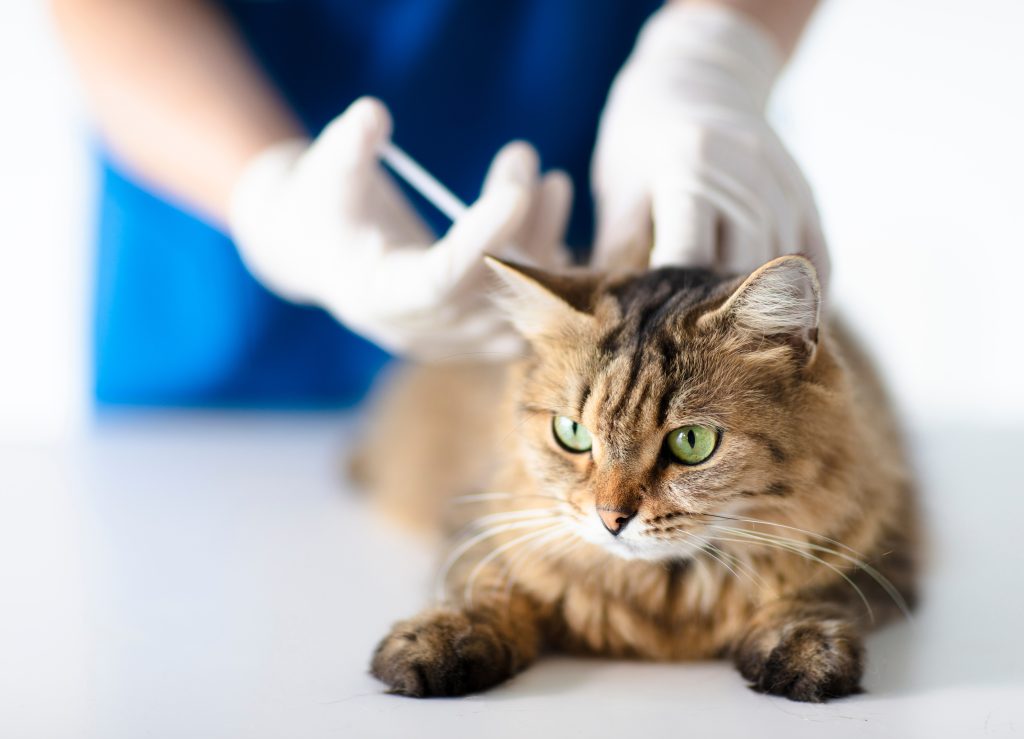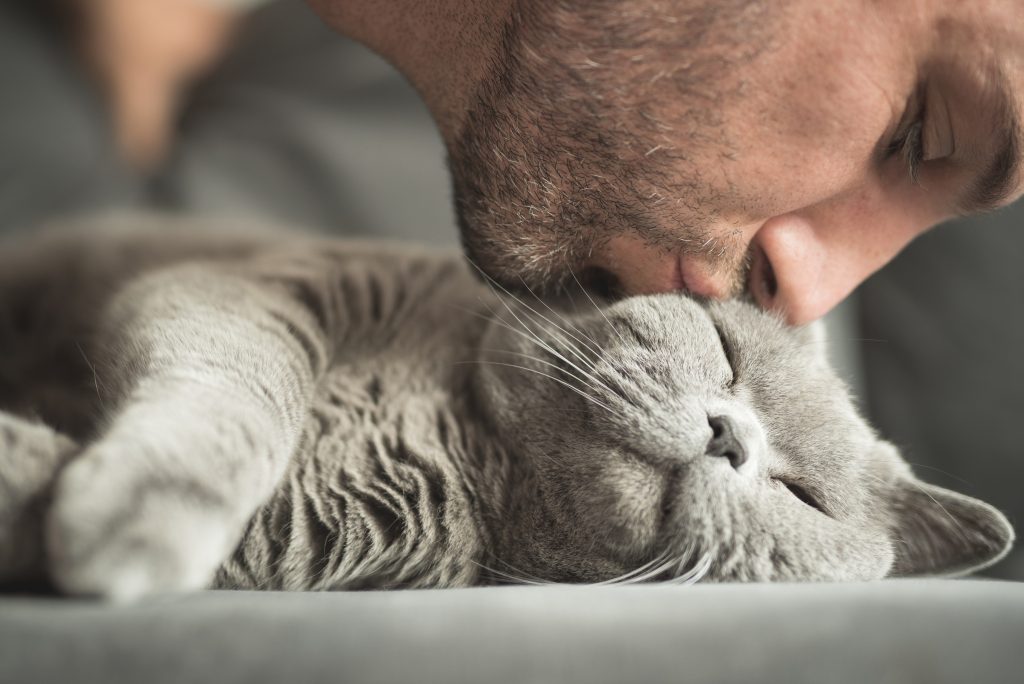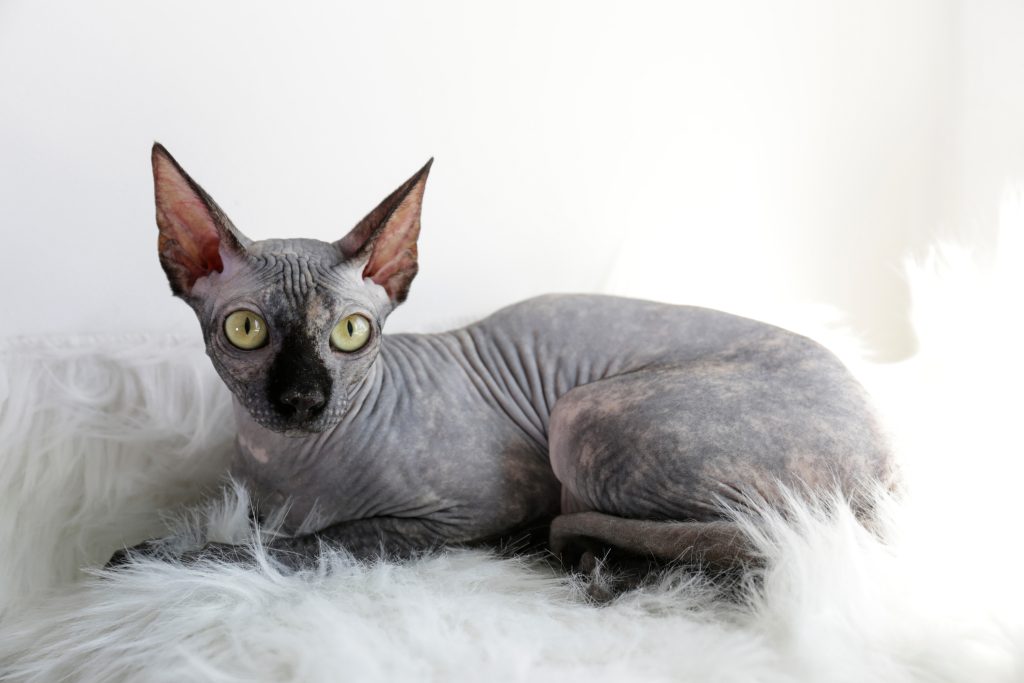How does a cat allergy develop in the first place and what are the symptoms?
What can cat lovers do to prevent allergies, and are there any specific breeds suitable for allergy sufferers?
Your cat is purring away next to you on the couch, but then, out of the blue, you start feeling like you have a cold. Your eyes start to itch and you get a runny nose and a scratchy throat. Are these symptoms signs of a cat allergy or are you just in the beginning phase of a cold? Well, if this supposed cold doesn’t go away, or if it keeps coming back – especially after you’ve had contact with a cat – it’s entirely possible that you’ve got yourself a cat allergy.
Can a cat allergy fade away over time? Or do the symptoms get worse?
What triggers a cat allergy
People often say they’re “allergic to cat hair”, but it’s not actually the cat’s fur that’s to blame! In fact, cat hair is only indirectly responsible for those typical allergy symptoms. A cat allergy is triggered by allergens, in particular an allergen called “Fel d 1” (Felis domesticus). Your cat produces these proteins in a number of its glands, including the anal, sebaceous and salivary glands. In other words, when your cat cleans itself and licks its fur, it distributes these proteins to its entire environment via saliva and dander (dried flakes of skin). So it’s not the actual fur that people are allergic to; it’s the allergens in the saliva sticking to the fur that trigger the allergy.

Cat allergy symptoms
The “Fel d 1” allergen is especially good at spreading throughout its environment, almost as if it had wings. It floats nimbly through the room and settles stubbornly in every nook and cranny. Breathing in allergen-saturated air and/or coming into contact with dust is sometimes all it takes to trigger allergy sufferers’ immune systems! Their body’s natural defence system springs into action, and once the reaction has been set in motion, the typical symptoms of a cat allergy soon appear.
Cat allergy: typical symptoms
- respiratory problems
- itchy eyes
- watery eyes
- skin rash
- cough
- hives
- sneezing
- sore throat
- headaches
- sleeping disorders

Is there a vaccine for cat allergies?
What about a possible vaccine for cat allergy sufferers? In fact, a serum called “HypoCatTM” was scheduled for introduction as a vaccine against cat allergies in 2022. However, it’s not us humans who would get the shot, but rather the creatures that produce the allergens in the first place, namely the cats. The vaccine contains the allergen “Fel d 1”, in this case modified to prompt the vaccinated cat to produces antibodies. The idea is to bind the allergens together in the cat’s body. With fewer allergens in circulation, allergy sufferers will be able to breathe a sigh of relief. Unfortunately, medical authorities have not been able to come to an agreement on the vaccine, so approval is still a long way away.

Treating your cat allergy
Anti-allergy medication can provide relief in the acute stages of an allergy. But those pills won’t eliminate the actual cause of your allergy; they’ll only give you temporary relief from the symptoms. This brief respite doesn’t mean the allergy is gone forever. If you’re interested in treating your cat allergy and becoming as symptom-free as possible, you should look into what’s called “allergy immunotherapy”. This desensitisation therapy takes time – often several years, depending on your disposition – so you’re going to need a lot of patience.
Ask your doctor
If you notice your cat allergy is getting worse, you should definitely see your doctor and ask for advice on what you can do about your symptoms. And don’t forget that it’s possible to get asthma from a cat allergy. Your doctor might refer you to a professional who specialises in the field of allergology. Or you can go directly to an allergy centre, which will have specialists who treat people with allergies and provide optimal care.

Home remedies for cat allergies
One thing you can do at home is wash your clothes and all textiles in your environment on a regular basis, including bed linen, curtains and blankets. You should also regularly damp-mop your floors and get a vacuum cleaner with a special anti-allergy filter. And don’t forget to always wash your hands after petting your cat. In addition to all this regular cleaning, there are other home remedies that can help to relieve your cat allergy symptoms:
TIP:
- Eye drops against red and itchy eyes
- Anti-inflammatory herbal teas
- Nasal rinses using salt water
Cats for allergy sufferers?
Is there a specific breed of cat that allergy sufferers can have at home without triggering their immune systems? Or do people diagnosed with cat allergies simply have to part with their beloved felines? Unfortunately, all cats – regardless of their breed – produce the protein “Fel d 1” in their anal, salivary and sebaceous glands. If you’re allergic to cats but you still want to own one, it’s better to get a female cat or a neutered male cat, because females and neutered males produce less “Fel d 1”.

Is there such a thing as a hypoallergenic cat?

The protein known as “Fel d 1” is the main cause of cat allergies, so if there was such a thing as a hypoallergenic cat, it would have to be an animal that doesn’t produce this allergen, one that loses hardly any hair and one that has little dander (dried flakes of skin). Don’t forget that cats spread the allergen by grooming themselves, among other things. They lick their fur, and if they shed some fur or flakes of skin in the process, these will spread out into the cat’s environment.
These cats are suitable for allergy sufferers
Some cats do, in fact, produce fewer allergens. However, this has less to do with the breed than with the cat itself, that is, with its individual constitution. Even though there are no studies to prove it, some purebred cats are said to have these characteristics. The following 8 cat breeds are purportedly suitable for allergy sufferers:
1. Russisch Blau
Here comes a beauty! The Russian Blue is neither too thin nor too fat. It has a long, slender body and a graceful appearance. Russian Blues make their way through life on long legs and dainty paws, with their bright emerald, almond-shaped eyes forming an impressive contrast to their silvery shimmering coat. Their ears are relatively large and their tail is long and tapered.

2. Sibirische Katze
As the name suggests, Siberian cats are the Russian iteration of a forest cat. In order for any animal to be able to survive in Siberia, it has to be particularly robust and capable of adapting to harsh conditions. One glance at the Siberian cat and you’ll find it easy to imagine it crossing the tundra. It’s a robust, muscular and resilient cat that’s able to defy the cold Russian winter with its thick coat.

3. Siamkatze
Even people who wouldn’t define themselves as cat connoisseurs are usually able to identify a Siamese cat. Its long body, distinctively marked coat, facial features and expressive deep blue eyes give it an appearance that clearly sets it apart from other pedigree cats. Siamese have strong personalities that demand attention but are also very affectionate once they’ve accepted their human companion into their heart.

4. Bengalkatze
Bengal cats are just as beautiful as wild cats, but also just as gentle and affectionate as house cats. It’s like having a “mini leopard” in your home, only they’re much more demonstrative and fixated on “their” human companions. Although they’re beautiful and appear majestic and self-confident, they’re usually extremely shy with humans, sometimes even preferring to stay out of our way completely

5. Burma-Katze
Burmese cats are very sociable, people-oriented felines who won’t leave your side. They’re great buddies and will always be there for you, as they crave contact and will always seek you out. In fact, a Burmese cat would think it’s being punished if you left it alone at home all day. Even though they’re considered to be quiet and balanced members of their species, they’re almost always up for playing. And they continue to be this way well into old age!

6. Rex Katzen
“If you need a friend, get a dog” was the advice given by Gordon Gekko, alias Michael Douglas, in the film Wall Street. But we’ll have to forgive him for saying that, because he probably never met a Devon Rex. The Devon is not a dull cat that takes naps all day long. On the contrary, the Devon is a pure bundle of energy and it’s very hard to slow them down. They’re always ready to pounce and constantly up to some sort of mischief.

7. Sphynx
The Sphynx is a so-called “naked cat”. It’s an extraordinary phenomenon, but not as new as you might think. Indeed, cats with almost no hair were already kept as pets during the Aztec empire. In order to breed Sphynx cats, both parents must have the specific gene that contributes to the absence of fur.

8. Balinesenkatze
When you look at a Balinese cat, you might think you’re looking at a Siamese cat with fur extensions. In fact, Balinese resemble their short-haired counterparts 1:1 in terms of coat colour and build. This is because of the origin of the breed: experts assume that a few Siamese cats mated with one or more long-haired variants at some point in the past.

In addition to cleaning everything thoroughly, there are some home remedies that can help relieve the symptoms of cat allergies. For example, you can use eye drops to relieve itching and reduce swelling and redness. Herbal teas can have an overall anti-inflammatory effect. And you can also do something good for your nasal mucous membrane by regularly rinsing your nose – gently, of course – with salt water.
A vaccine against cat allergies has yet to be approved. And when that day does arrive, it won’t be the cat owner who gets the vaccine, but the creatures that produce the allergen in the first place, namely cats. The idea is that the vaccinated cat would produce antibodies and the allergy-causing proteins would stay in the cat’s body. With fewer allergens in circulation, allergy sufferers might actually be able to breathe a sigh of relief.
The introduction of the “HypoCatTM” vaccine against cat allergies was planned for 2022. The vaccine contains the allergen “Fel d 1”. It has been modified in such a way that the vaccinated cat forms antibodies and the protein is bound in the cat’s body. However, medical authorities have not yet been able to come to an agreement, so approval is still a long way away.
Basically, all cats, regardless of breed, produce the protein “Fel d 1” in their anal, salivary and sebaceous glands. If you’re allergic but still want to own a cat, it’s better to get a female cat or a neutered male, because females and neutered males produce less “Fel d 1”. This means that there will be fewer allergens circulating in your environment.
The protein known as “Fel d 1” is the main cause of cat allergies, so it makes sense that cat breeds that don’t produce this allergen or shed any hair would be most suitable for allergy sufferers. This is because when cat hair or dander (dried flakes of skin) containing saliva is shed from the cat’s coat, it gets distributed throughout the environment and often triggers the cat allergy.
Are there cats that produce hardly any allergens and shed less hair and dander (dried flakes of skin)? Even though there’s no definitive research to prove it, there are some cats that are said to have these characteristics: Russian Blue, Siberian, Siamese, Bengal, Burmese, Rex, Sphynx and Balinese.
Bengal cats, which are just as beautiful as wild cats, but gentle and affectionate like house cats, are said to be suitable for allergy sufferers. It’s like having a “mini leopard” in your home, except that they’re much more affectionate and fixated on “their” human companions. They are beautiful cats with a confident and majestic demeanour.
Burmese cats are also said to be suitable for allergy sufferers. They’re very sociable, people-oriented felines who simply won’t leave your side. Burmese cats are actually considered to be quiet and balanced members of their species, but they’re almost always up for playing. And they continue to be this way well into old age!
So-called “naked cats” don’t have any fur, so many would argue that they’re also suitable for allergy sufferers. The Sphynx is a naked cat. It’s an unusual phenomenon, but not as new as it may seem, because cats with almost no hair were already kept as pets in the Aztec empire.
The honest answer is that it depends. Some cats, regardless of their breed, excrete fewer allergens. And female cats and neutered males produce less of the allergy causing protein known as “Fel d 1”. Basically, before you decide to get a cat, you should always test to see if you have any allergic reaction to your potential new roommate. It’s better to be safe than sorry.
A cat allergy is triggered by allergens, in particular by an allergen called “Fel d 1” (Felis domesticus), which spreads throughout the cat’s environment via its saliva and dander (dried flakes of skin). When a person with a cat allergy is exposed to these allergens, whether by inhaling them or via some other form of contact with the cat, that person’s immune system will kick into gear and prompt an allergic reaction.
Yes, it’s possible to get a cat allergy all of a sudden, even if you haven’t been allergic to cats for years. Your symptoms might suddenly appear out of the blue, from one day to the next. Even without a cat right next to you or in your direct vicinity, those powerful allergens can trigger a sudden allergic reaction.
A cat allergy can get worse if you fail to avoid contact with the allergens and/or if your contact intensifies. It’s also possible for allergy sufferers who have regular or excessive contact with allergens to develop a respiratory illness. In the worst case scenario, an allergy sufferer might start having cardiovascular problems and completely collapse – this can even be life-threatening.
Yes, a cat allergy can disappear. In other words, it can sometimes go away as quickly as it came. Either that or the symptoms might stop being as intense or appear only sporadically. In this case, allergy sufferers’ immune systems will no longer react in such an extreme manner and people who previously suffered from these symptoms will suddenly feel “liberated”.
The typical symptoms of a cat allergy are very similar to the symptoms of other allergies. Here, too, they include increased respiratory problems, itchy eyes, watery eyes, skin rashes, coughing, hives, sneezing, a sore throat and headaches. Some cat-allergy sufferers also experience sleeping problems.
The symptoms of a cat allergy in children are the same as in adults. When a child’s immune system identifies allergens in its environment as being “dangerous” and initiates the first defence reactions, the child will experience the same type of symptoms, including itchy eyes, red eyes, a runny nose and skin changes.
A cat allergy can manifest itself even after very brief contact with allergens. Your eyes, nose and skin are the first to be affected. Your eyes might get red and itchy. You might find your nose running non-stop. And your eyes might start watering too. It might feel like your body is trying to “wash away” the allergens.
In the acute stage, anti-allergy medication can help to provide relief. But those pills won’t fight the actual cause of your allergy; they’ll only give you temporary relief from your symptoms. This brief respite doesn’t mean the allergy is gone forever! If you want to treat your cat allergy and become as symptom-free as possible, you should consider first taking an allergy test and then undergoing allergy immunotherapy.
